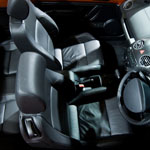Whiplash
Whiplash Compensation Claim
Whiplash is fast becoming an epidemic in the UK. In 2007 432,000 people claimed for whiplash and it accounts for three quarters of all motor accident claims. These statistics contradict the Governments own statistics that “slight” injuries from road traffic accidents are falling. This is mainly because the Government statistics only take into account accidents which are reported to the police and whiplash often goes unreported. Whiplash occurs when the soft tissue in the spine has been stretched and strained caused by the body being thrown forwards in a sudden, forceful jerk. It most commonly occurs in rear-end shunts where the collision pushes the car forward, shortly followed by your body, the head tilts down towards the steering wheel slightly while the neck extends forward. However, when you brake hard the car stops suddenly causing your head and extended neck to be thrown backwards into the head restraint.
The common symptoms of whiplash are:
- Neck pain and stiffness
- Neck swelling
- Tenderness at the back of the neck
- Loss of movement in the neck
- Headaches
While other symptoms can be:
- Lower back pain
- Paraesthesia or pins and needles
- Muscle spasms
- Dizziness
- Tiredness
- Difficulty in swallowing
- Blurred vision
- Tinnitus or ringing ears
There is no particular treatment for whiplash, but applying an ice pack wrapped in a tea towel to your neck can help as can painkillers. Initial rest is recommended, but as the pain eases try to move your neck gently increasing the range of neck movement and try to continue with normal activities. Although most symptoms disappear after a few days, some last for a few months and according to research 24% of patients still have symptoms after 1 year. You are more likely to have continued symptoms if your head was rotated or inclined at the time of the collision. In an accident that causes whiplash someone is at fault and the victim could have a very good claim for compensation.
The main cause of whiplash is through drivers tailgating the car in front; in 2007 it contributed to 8,853 crashes. Tailgating reduces the distance between you and the car in front making you reliant on the person in front stopping in time should something occur on the road ahead. It also reduces your own reaction time: if the car ahead brakes suddenly you have less time to respond so are more likely to hit the back of their car which could cause whiplash. In Government proposals when people are learning to drive more emphasis is to be put on safe following distances, recommending a 2 second gap, hence the phrase: “only a fool breaks the 2 second rule.”
Unfortunately in many cases whiplash could have been prevented because the head restraint was not correctly positioned and this is a major factor contributing to whiplash. The Association of British Insurers wants car retailers to demonstrate to potential buyers how to adjust head restraints on new cars as many people don’t know how to adjust them and are also unaware of their significance in helping prevent whiplash. It has also been proposed that leaflets on correctly positioned head restraints should be issued with MOTs. The head restraint should be level with the top of your head and there shouldn’t be a gap between your head and the restraint.
More recently manufacturers have been developing anti-collision technology and protective vehicle seat designs to help reduce the number of cases of whiplash. At the moment manufacturers are using radar, laser and optical sensor systems to create adaptive cruise control which automatically maintains a safe distance between you and the car in front; collision mitigation braking systems which warn the driver visually and audibly of potential collisions and low speed avoidance systems which automatically brake when an object is within 6m of the car and the drivers is not reacting quickly enough. Head restraints have been designed to react and protect your head by moving upwards and forwards during a collision while seats can absorb energy from collisions and allow occupants to make contact with head restraints without straining the neck. According to Thatcham’s research into whiplash ratings in 2008, 36% of cars have good whiplash prevention systems compared to only 16% in 2005.










